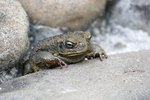Baby frogs require special care, especially in feeding, to survive and live to adulthood. As amphibians, they also require a habitat relative to their natural habitat to thrive.
Things You'll Need
A glass aquarium
A piece of plexiglass cut and sanded
Nontoxic aquarium sealant
Aquarium gravel
Substrate like potting soil or sand
Distilled water
Plants, logs or other hides
A water dish for dry-environment species
Crickets, worms and other insects
Reptile diet powder for insects
Building the Habitat
Step 1: Choose an Aquarium
Many toads and some frogs live in dry, arid environments and do not do well in aquatic conditions. Others require much more water. Consult a herpetologist -- a reptile scientist -- if you aren't sure about your frog. Match the frog's enclosure as closely as possible to its natural habitat and consider the adult size of your frog before deciding. Most species do well in 20-gallon aquarium tanks. Make sure to choose a secure-fitting lid as well. Baby frogs are adept escape artists.
Step 2: Add Substrate
Many semiaquatic species, like the firebellied toad, are happiest in an enclosure that is half dry land and half water. Cut a piece of plexiglass to the width of the tank and to a height equal to the length of a full-grown frog of whichever species you will own, plus one inch. Sand the top edge until it's rough but not sharp -- your frogs will climb over this from water onto dry land. Secure this plexiglass in the middle bottom of the tank with aquarium sealant. You should now have two equal sides with a piece of plexiglass between them. Layer both sides with just enough aquarium gravel to cover the glass, then build one side of the tank up with another type of substrate like sand or potting soil right to the level of the plexiglass.
Step 3: Add Water
Use distilled water to fill the other side of the enclosure. If your frog is from a warm or tropical environment, a water heater may be necessary. Getting the temperature right is especially important for baby frogs. Use a low-power aquarium filter to keep the water clean. If you're providing a dry environment for arid-habitat species, provide a water dish at least large enough the frog to submerge itself.
Step 4: Add Plants and Hides
Frogs require places to hide. Using a hollowed-out half-log on the dry side of their tank lets them get under cover when they are tired or feeling threatened. Adding real or artificial plants to the enclosure also helps to mimic frogs' natural environment. These plants and hides also retain moisture, which will help keep humidity high for species that require it. Use a stick or long piece of bark in the water, leaning onto the plexiglass, to provide your frog with another way from water to land.
Tips
Frogs receive all their necessary vitamin D3 from their diet and as such do not require full-spectrum reptile lighting. Normal lights will work fine for them.
Caring Specifically for Baby Frogs
Once froglets have absorbed their tadpole tails and become frogs, their care is very similar to that of adult frogs. The only difference is in feeding. Growing frogs require more regular feeding than adults. Feed your frogs daily, usually at dawn or in the evening, depending on the species' natural schedule.
As carnivores, frogs must be fed insects. Crickets are ideal for baby frogs, as pet stores carry them in a variety of sizes. Use insects that are not longer than your frog's mouth is wide. This will prevent choking and ensure that the insects don't harm your frog. Remove uneaten food at dawn if fed in the evening, and in the evening if fed at dawn. As your frogs grow, they can start to take larger insects, like earthworms.
Tips
Sprinkle crickets with reptile diet powder two or three times per week to ensure that your frog gets the vitamins and minerals he needs.
Do not touch or hold your baby frog if not absolutely necessary. Not only are baby frogs' skeletal structures fragile, but many frogs absorb chemicals through their skin and may pick up anything you may have on your hands. Baby frogs are especially sensitive to outside chemicals. Observe your baby frog's behavior from outside of his enclosure instead.
Warnings
Do not house baby frogs with larger frogs. A small-enough baby can become a meal for your larger critters.





